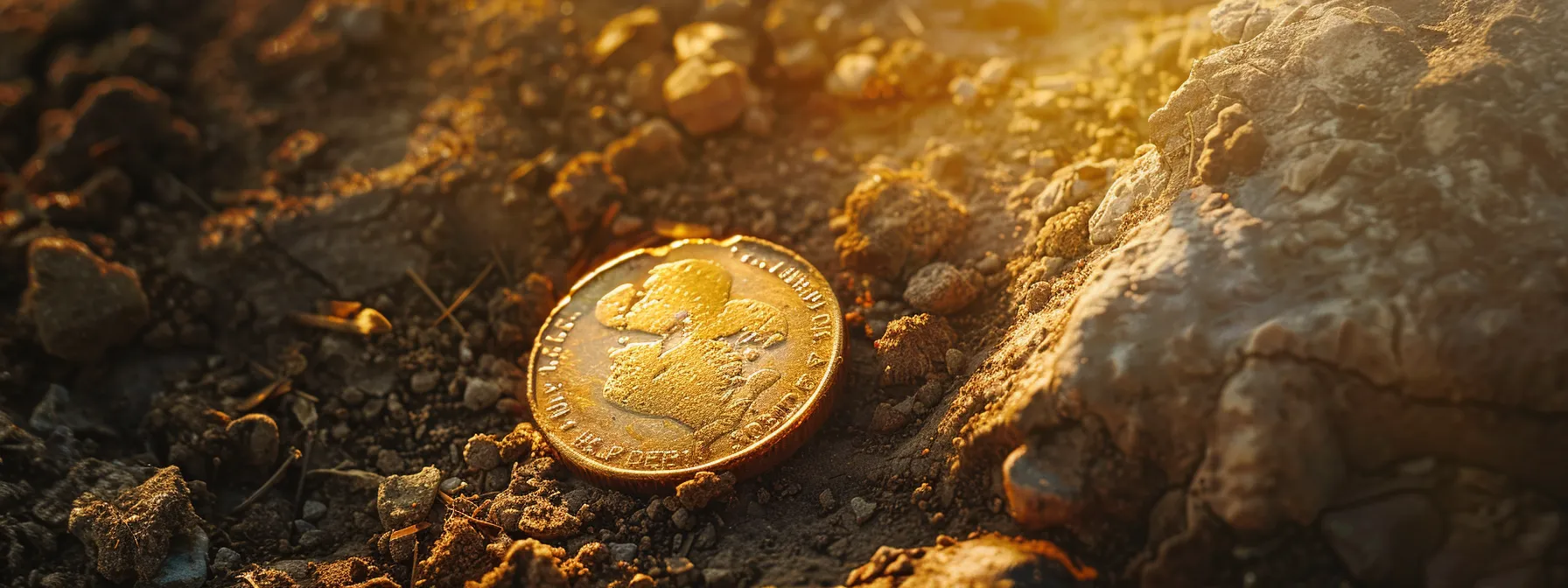

Are you ready to start your journey into treasure hunting but unsure of where to begin? Understanding the right entry level metal detector is crucial for finding hidden treasures in soil, sand, and beyond. In this article, I’ll review top entry level metal detectors, guide you on choosing the best option for beginners, and share tips to maximize value from your new detector. Whether you’re searching for old coins or dreaming of gold mining, this guide will help you avoid common pitfalls and set you up for success.
Key Takeaways
- Entry-level metal detectors are perfect for beginners due to their affordability and user-friendly features
- Understanding essential specifications like frequency and depth detection is crucial for success
- Practicing in varied terrains enhances detecting skills and improves treasure identification
- Connect with the metal detecting community for support, knowledge sharing, and new hunting opportunities
- Regular maintenance and use of quality accessories boost efficiency in treasure hunting adventures
Understanding Entry Level Metal Detectors

Entry-level Metal Detecting Campsites serve as an excellent starting point for anyone diving into the world of treasure hunting. These beginners’ models offer numerous benefits, including ease of use and affordability. As I explore essential features, such as submersible capabilities and target discrimination, you’ll discover how these detectors enhance your prospecting experience. Understanding these Beach Metal Detecting Tips will help you confidently choose the right metal detector for your treasure-hunting adventures.
Defining Entry Level Metal Detectors
Entry-level metal detectors are designed specifically for newcomers to the treasure hunting world. They typically feature user-friendly controls, affordability, and essential functions like discrimination, which allows you to distinguish between valuable targets like gold and silver relics and less valuable items, such as iron. This makes them ideal for those starting out, providing them with the tools necessary for successful gold prospecting and the thrill of uncovering hidden treasures.
- User-friendly controls for beginners
- Affordability without compromising essential features
- Target discrimination to differentiate valuable finds
- Ideal for locating relics and precious metals
Benefits of Starting With a Beginner Model
Starting with a beginner metal detector can significantly enhance your treasure hunting experience. These machines often utilize very low frequency (VLF) technology, allowing them to easily differentiate signals in various magnetic fields. As I’ve discovered in my own hunts, a good entry-level model reduces noise from less valuable items, helping you focus on uncovering valuable targets like coins and relics, making your searches more effective and enjoyable.
Essential Features to Look For
When choosing an entry-level metal detector, there are a few essential features that can greatly impact your treasure hunting success. I recommend looking for a model that operates at a suitable frequency for finding specific targets like gold nuggets and copper coins. Additionally, consider the weight of the detector; a lighter model can make long searches more enjoyable without tiring you out. Also, ensure it runs on standard AA batteries for convenience and easy replacement in the field:
- Frequency for identifying specific targets
- Lightweight design for comfort during use
- Standard AA battery compatibility for easy power supply
Now that we understand the basics of entry level metal detectors, it’s time to look closely at some of the best models on the market. These detectors can make all the difference in your treasure hunting journey, promising both excitement and discovery.
In-Depth Reviews of Top Entry Level Metal Detectors

I’ll delve into three top entry-level metal detectors that stand out for fresh water hunting and other environments. First, I’ll cover [Metal Detector Model A] with its features and user feedback. Then, we’ll explore [Metal Detector Model B], discussing its performance and value. Finally, I’ll weigh the pros and cons of [Metal Detector Model C] and compare these models side by side to help you find the best metal detectors for your treasure-hunting adventures at Loot Detective Home.
[Metal Detector Model A]: Features and User Feedback
[Metal Detector Model A] is a solid choice for beginners, especially for those looking to explore the Best Metal Detecting Spots whether it’s on a beach or at a favorite campsite. Its user-friendly interface and reliable target discrimination make it easy to spot valuable items like coins, gold, and silver, which I’ve found particularly useful during my own adventures. I often recommend checking out a local Metal Detector Store like Kellyco Detectors to find this model, as it offers a great balance of features and affordability, perfect for newcomers to treasure hunting.[Metal Detector Model B]: Performance and Value
[Metal Detector Model B] is a formidable contender in the entry-level market, showcasing remarkable performance and value. During my outings, I’ve consistently found that its depth detection capabilities help me locate treasures deeper in the ground, whether I’m hunting at Ott’s Club or exploring other historic sites. Users rave about its reliability and the ease with which it adapts to varying terrains, making it a terrific choice for both beginners and seasoned treasure hunters alike.[Metal Detector Model C]: Pros and Cons
[Metal Detector Model C] offers a great mix of features that cater to entry-level users, but it comes with its own set of advantages and challenges. On one hand, I appreciate its reliable target identification and decent depth detection, making it suitable for casual treasure hunts. On the other hand, I’ve noticed it can struggle slightly with ground mineralization, which might frustrate beginners in more demanding environments.- Pros: Reliable target identification and depth detection.
- Cons: Struggles in highly mineralized ground conditions.
- Ideal for casual treasure hunts.
- Great balance of features for the price.
Comparing the Top Models Side by Side
When comparing top entry-level metal detectors, it’s crucial to look for specific features that match your treasure hunting needs. Each model offers distinct advantages that cater to different environments and types of finds. For example, while [Metal Detector Model A] excels in user-friendliness and portability, [Metal Detector Model B] provides superior depth detection, making it ideal for exploring historical sites. Understanding these differences can help you make the best choice to enhance your treasure hunting experience:
- [Metal Detector Model A]: User-friendly and portable.
- [Metal Detector Model B]: Superior depth detection for historical sites.
- [Metal Detector Model C]: Reliable identification, but struggles with mineralized ground.
Choosing the right metal detector can feel like a new adventure. Let’s break down how to find the best one for your treasure hunting journey.
How to Choose the Best Metal Detector for Beginners

To find the right entry-level metal detector, start by identifying your metal detecting goals, whether you’re searching for coins, relics, or gold. Next, evaluate essential specifications like frequency and depth detection. Balancing your budget with quality is crucial to avoid less effective models. Lastly, read and interpret user reviews to gauge real-world experiences, ensuring you make an informed decision.
Identifying Your Metal Detecting Goals
Identifying your metal detecting goals is the first step in selecting the right entry-level metal detector. Are you focused on finding coins, relics, or maybe even gold? Each target type requires different characteristics in a detector. For example, if you’re after coins in parks or on beaches, you might prioritize discrimination features that separate valuable finds from trash, while a focus on gold nuggets may require a detector with higher frequency capabilities for better sensitivity.
- Determine whether your goal is to find coins, relics, or gold.
- Prioritize features that match your targeting needs.
- Consider the environments you’ll be searching in, like beaches or parks.
Evaluating Important Specifications
When evaluating important specifications for entry-level metal detectors, I always recommend looking closely at the detector’s frequency, sensitivity, and depth detection capabilities. A higher frequency can improve sensitivity to smaller targets like gold, which I’ve found invaluable during my hunts. Additionally, examining how deep the detector can effectively search allows you to target treasures buried further underground, enhancing your chances of finding valuable items.
Balancing Budget and Quality
When it comes to balancing budget and quality for entry-level metal detectors, it’s crucial to find a model that meets your needs without breaking the bank. In my experience, many budget-friendly detectors perform admirably for beginners, but you should watch out for features that enhance functionality, like good discrimination and depth detection. Investing a little more in a reliable detector can pay off significantly in your treasure hunts, as it increases the chances of finding valuable items while keeping your frustration levels low:
- Look for durability and warranty options to ensure long-term use.
- Compare features across different models to find the best value.
- Read user reviews to understand performance versus cost.
Reading and Interpreting User Reviews
Reading user reviews can significantly influence your choice of entry-level metal detectors. I’ve found that real user experiences provide valuable insights that go beyond what is listed in product specifications. Pay attention to comments about the detector‘s ease of use, performance in different environments, and customer support, as these factors can help you determine if the model will meet your hunting needs:
- Look for feedback on ease of use and setup.
- Check for comments regarding field performance and target recovery.
- Consider user experiences with customer service and warranty issues.
You have your metal detector, and the adventure begins. It’s time to learn how to get the most out of your entry-level gear and uncover the treasures waiting beneath your feet.
Maximizing Value With Your Entry Level Detector

To truly maximize the value of your entry-level metal detector, it’s crucial to adopt effective metal detecting practices and prioritize maintenance for longevity. In this section, I’ll share tips that can greatly enhance your treasure hunting experience and discuss essential accessories that can take your detection efforts to the next level. These insights will ensure you not only enjoy your new detector but also increase your chances of finding hidden treasures.
Tips for Effective Metal Detecting Practices
To maximize the value of your entry-level metal detector, it’s essential to adopt effective metal detecting practices. Start by learning your detector’s settings and capabilities; this will help you understand how to best utilize features like discrimination and sensitivity. I’ve found that practicing in varied terrains enhances my skills, making me more adept at identifying valuable treasures in the field.
- Understand your metal detector’s settings.
- Practice in different terrains to improve skills.
- Pay attention to environmental factors like soil type and moisture.
- Keep your detector clean and well-maintained for optimal performance.
- Join local metal detecting clubs for tips and camaraderie.
Maintaining Your Detector for Longevity
To maintain your entry-level metal detector for longevity, regular cleaning and careful storage are essential. I make it a habit to wipe down the coil and shaft after each use, especially after hunting in wet or muddy conditions, which helps prevent corrosion and wear. Additionally, I store my detector in a cool, dry place and ensure that batteries are removed when not in use to avoid leakage, preserving both performance and functionality for future treasure hunting adventures.
Accessorizing to Enhance Your Experience
Accessorizing your entry-level metal detector can significantly boost your treasure hunting experience. I’ve found that adding items like a quality digging tool, a pinpointer for precise target location, and a comfortable carrying strap can make all the difference in the field. By equipping yourself with these helpful accessories, you can enhance your efficiency and ease while searching for those hidden treasures.
- Quality digging tool for efficient excavation.
- Pinpointer for accurate target location.
- Comfortable carrying strap to ease the load.
- Headphones for better audio clarity in noisy environments.
- Finds pouch to keep your treasures organized.
With your entry-level detector in hand, you’re ready to uncover the past. Let’s take those first steps into the world of metal detecting, where adventure awaits and treasures lie buried beneath the earth.
Getting Started: First Steps in Metal Detecting

Mastering your entry-level metal detector starts with learning the basic operation and settings that can enhance your detecting experience. Knowing where to search is equally important, so I’ll guide you on finding suitable locations that are ripe for exploration. Lastly, understanding the laws and ethical considerations ensures that we respect history and the environment while treasure hunting. Each of these aspects plays a crucial role in making your adventure safer and more fruitful.
Learning Basic Operation and Settings
Getting comfortable with the basic operation and settings of your entry-level metal detector is essential for a fruitful treasure hunting experience. I recommend starting by familiarizing yourself with the user’s manual, as it provides valuable insights into the specific features and adjustments your detector offers. Understanding how to adjust settings like sensitivity and discrimination will enhance your ability to identify valuable treasures while filtering out unwanted signals.
- Study the user’s manual for your metal detector.
- Learn to adjust sensitivity and discrimination settings.
- Practice in different environments to improve your skills.
Finding Suitable Locations to Explore
Finding suitable locations to explore with your entry-level metal detector can make all the difference in your treasure hunting experience. I often start by visiting parks, beaches, and historical sites where people frequently gather; these places are rich with potential finds like coins and jewelry. Additionally, it’s beneficial to research local regulations and permissions before hunting, as this ensures that you can explore these areas ethically and legally, ultimately enhancing your adventure and honing your skills as a treasure hunter.
Understanding Laws and Ethical Considerations
Understanding the laws and ethical considerations surrounding metal detecting is essential for every treasure hunter. Before you set out with your entry-level metal detector, I always recommend checking local regulations regarding where you can search and what you can keep. Respecting these legalities not only protects your passion for detecting but also honors the history of the items we find and the environments we explore:
- Research local laws and regulations to avoid fines.
- Seek permissions when detecting on private property.
- Report significant archaeological finds to authorities.
- Practice responsible treasure hunting by leaving the environment as you found it.
You’ve learned the basics and felt the thrill of discovery. It’s time to take your passion further and explore the depths of detecting with advanced techniques and tools that can lead to greater treasures.
Advancing Your Metal Detecting Journey

As I continue my metal detecting journey, setting personal challenges and goals keeps my passion ignited. Connecting with the metal detecting community not only broadens my knowledge but also enhances camaraderie among fellow enthusiasts. Exploring options for future upgrades helps me elevate my treasure hunting experience while ensuring I maximize my entry-level detector’s potential.
Setting Personal Challenges and Goals
Setting personal challenges and goals is a fundamental part of my metal detecting journey. Whether it’s aiming to find a specific type of relic, like old coins or jewelry, or simply improving my skill in detecting different terrains, creating these targets pushes me to stay engaged and driven in my treasure hunting pursuits. By tracking my progress and celebrating small victories, I keep the excitement alive while also honing my techniques:
- Establish specific finds, such as relics or rare coins.
- Track personal progress over time to stay motivated.
- Engage with local metal detecting communities for shared goals.
Connecting With the Metal Detecting Community
Connecting with the metal detecting community has been one of the most rewarding aspects of my treasure hunting journey. I’ve discovered that sharing experiences, tips, and techniques with fellow enthusiasts enhances my knowledge and skill set significantly. Participating in local clubs or online forums not only helps keep my passion alive but also opens doors to potential hunting partners and new locations that could yield hidden treasures.
- Sharing experiences and tips improves knowledge and skills.
- Joining local clubs or online forums fosters connections with other enthusiasts.
- Collaboration opens doors to new hunting locations.
Exploring Options for Future Upgrades
As I progress in my metal detecting journey, considering upgrades becomes essential for enhancing my treasure hunting experience. I’ve found that moving to a mid-range or advanced detector can provide additional features like better discrimination, enhanced depth capabilities, and advanced technology, allowing me to adjust my settings for various environments. Exploring brands known for their reliability and user satisfaction can significantly expand my potential finds, making upgrades a worthwhile investment for anyone serious about treasure hunting.
Conclusion
In summary, understanding entry-level metal detectors is crucial for anyone looking to embark on a treasure hunting journey. These comprehensive reviews highlight the essential features, benefits, and top models, empowering beginners to make informed decisions. By emphasizing the importance of setting goals, evaluating specifications, and connecting with the metal detecting community, you can maximize your chances of finding hidden treasures. Equip yourself with the right knowledge, and you’ll unlock a rewarding adventure in the world of metal detecting.


